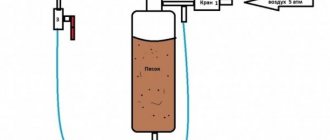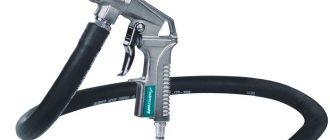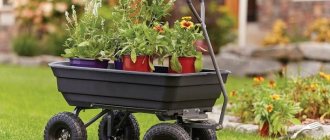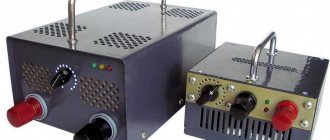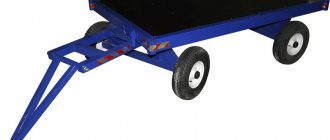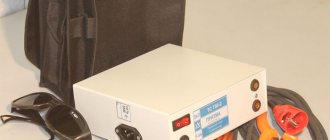Somehow I came across a similar idea on how to make a sandblasting gun on YouTube, and I thought that this was not a workable unit at all. Then I decided it was still worth seeing what would come of it. If I fail, I lose almost nothing in money. To my great surprise, hand sandblasting works, and quite well.
The attached video has a little more detail than the article and shows the homemade sandblasting gun in action.
When assembling a sandblasting gun with your own hands, you will need:
- Inexpensive sprayer
- Transition coupling from external to internal thread 1 cm
- Teflon tape
- Empty plastic bottle 0.5 l
- Glue gun
- File or sander
- Air compressor
- Drill with a set of drills
- Sandblasting abrasive (I used glass abrasive)
- Utility knife
Operating principle and purpose of the sandblasting machine
A sandblasting gun or other type of abrasive device purchased at a low price most often does not last long. The main parts of a cheap design quickly deteriorate and wear out, causing the device to become unusable. In order to save on the purchase of a high-quality device, you can use a homemade pistol, which works on the same principle as a magazine pistol.
The abrasive material (most often ordinary fine sand), under the influence of air from the flow created by the compressor, moves through a reinforced hose to the installation opening. It is fed through a nozzle directly onto the surface to be treated. Due to the high pressure, the sand moves, its particles act with high energy and clean off any contaminants. The installation itself is connected to a compressor on one side, and to a separate sand bunker on the other using special hoses.
In addition to cleaning surfaces from dirt, a sandblasting gun performs a number of other tasks:
- removal of old coatings;
- eliminating traces of corrosion;
- glass frosting;
- degreasing surfaces.
When using the machine, it is important to pay attention to the quality of the sand. It should be fine, clean, sifted through a sieve with the smallest mesh. When using contaminated coarse sand, the device nozzle becomes clogged and the gun breaks.
Device
First, you should consider what components sandblasting consists of in order to clearly understand how to make it.
Regardless of the design of the device, sandblasting must have a common flow of abrasive and exiting air. If the assembly is carried out according to a pressure type scheme, then the sand, due to the application of pressure, will enter the outlet type pipe, where it will be mixed with air supplied by the compressor. In order for a vacuum to form in the abrasive supply channel, the so-called Bernoulli effect is used.
The supply of sand to the mixing area is carried out exclusively under the influence of atmospheric pressure.
The ability to make sandblasting from a fire extinguisher or other available means in various ways is explained by the fact that you can use a lot of things and materials that, at first glance, seem unnecessary.
The homemade version is made on the basis of standard schemes, which may differ from each other only in the method of supplying sand to the part to be cleaned. But no matter what the diagram (drawing) of the device is, they will all include the following elements:
- a compressor that will pump the air mass;
- a gun that will be used to supply the abrasive composition to the surface requiring cleaning;
- hoses;
- abrasive storage tank;
- a receiver will be required to form the required supply of oxygen.
To increase the time of continuous use of the equipment and maintain the pressure necessary for high-quality operation, a moisture separator should be installed.
If a plunger-type compressor is used, then a mechanism should be installed on the air channel responsible for the intake that will filter the oil.
Design features
In order for the technical system to function correctly, it provides the following devices:
- sand nozzle with ceramic or steel tip;
- handle with trigger for controlling the device;
- fittings for connecting hoses necessary for supplying compressed air and sand;
- hoses for incoming abrasive and forced air;
- intake pipe or suction valve;
- a sand container with an outlet (for example, a small metal barrel or bottle).
The ideal option is to use homemade sandblasting not in the open air, but in a special chamber, which will increase work efficiency and reduce abrasive consumption. The chamber can be a box made of metal sheets, which is welded independently. Most factory camera models include the following items:
- glass viewing window for monitoring the material processing process;
- lighting system;
- two holes for gloves, in which the master places his hands;
- a grate at the bottom of the chamber and a chute for pouring waste sand;
- ventilation system to remove dust.
It is better to purchase the nozzle ready-made rather than making it yourself, this way it will last longer. It is almost impossible to make a nozzle of decent quality by hand. You will also have to buy a compressor, or take an old device that is available.
Homemade apparatus from a bottle
Step-by-step instruction:
- It is necessary to purchase a pneumatic gun with pressure ratings of up to 4 MPa, and also prepare a liter plastic bottle.
- The belt under the bottle cap should be cut off.
- Under the cover it is necessary to make two 5 mm holes opposite each other.
- The tube of an air gun is inserted into these holes and the place where the bottle of sand will be located is marked.
- An oblong hole is sawed into the tube for the abrasive to enter.
- The tube is reinserted into the bottle with the hole facing down and secured with superglue.
- Sandblasting is ready. Now you need to connect it to the compressor and fill it with sand (maximum fraction size - 0.5 mm).
Accessories
In addition to the compressor and nozzle, before making a sandblaster, you need to prepare other necessary materials and tools. Most of them are available in every home workshop, but some will have to be purchased at a hardware or hardware store.
A used gas cylinder made of high-strength metal is suitable as a container for abrasive. The tightness of the cylinder also allows it to be used for storing and supplying sand. To make it more convenient to pour sand, you can weld a small piece of pipe to the top of the cylinder, which will serve as a “neck”. Instead of a cylinder, you can use any barrels or containers.
If buying a ready-made compressor causes financial difficulties, you can build it yourself. The basis will be a compressor head from a MAZ or ZIL pneumatic drive, the power of which is sufficient to create a good sandblast. The head must be equipped with a receiver, although you can work without it - then air will be taken in constantly.
Depending on the complexity of the finished structure, other components may be required:
- Ball Valves;
- rubber hose with reinforced inserts with a diameter of 14 mm or more;
- air hose with a diameter of up to 10 mm;
- fittings for attaching hoses or collet clamps;
- transition coupling;
- FUM tape for sealing and connecting elements;
- empty 0.5 liter plastic bottle;
- glue gun and hot glue;
- grinding machine or file, sandpaper with a block;
- drill with drills;
- sharp knife;
- Bulgarian;
- pliers.
Tools and materials
To obtain a sandblaster from a fire extinguisher, you will need to have the following tools and spare parts on hand:
- a pair of ball valves;
- fire extinguisher container, gas or freon cylinder; a pair of tees;
- part of the pipe for forming a funnel for pouring abrasive;
- hoses having an internal size of 1 and 1.4 centimeters, intended for releasing abrasive and supplying air mass from the compressor;
- clamps with fittings used to secure hoses;
- Fum-tape is a plumbing type, the use of which allows you to connect the structural parts of the assembled model.
Which compressor to choose for a homemade sandblasting installation
It is desirable that the compressor capacity be at least 300 liters/minute, power - from 3 kW, air pressure - 6-7 atmospheres, and have overheating protection. For domestic purposes, a device operating from a 220 V network is suitable. If the compressor has a receiver, it will help avoid pressure drops when switching to different operating modes.
When a compressor is purchased ready-made, you need to pay attention to the type of equipment:
- Pressure type compressor. The abrasive material is fed into the system under the influence of compressed air and its own mass. Compressors of this type are considered professional and have high performance. With their help, surfaces of large areas are processed - bridges, buildings, ships, railway cars, complex structures. It is not advisable to use pressure compressors for domestic use.
- Injection type compressor. Such devices operate due to the pressure created by the air flow, which moves the sand inside the system. They are much cheaper, so they are well suited for small amounts of work at home.
Sandblasting chamber
To reduce the consumption of sand, which scatters to the sides and is wasted significantly, you can use a special chamber. It is not difficult to do it yourself, although it will require time and financial investment. It is necessary to weld metal sheets into a box and install glass in the body to visualize the process. 2 holes are drilled in front, to which 2 rough permanent gloves are attached. The bottom is made of thick wire or lattice, and underneath there is a plastic or metal trench for discharging abrasives. The sandblasting gun is installed inside the chamber, which is most conveniently located on the table.
How to make sandblasting with your own hands
In action, a homemade sandblasting machine performs no worse than a purchased one if it is designed correctly. Below is a method for creating a simple mini gun.
Nozzle installation
You need to purchase a ready-made sprayer with a nozzle. If the kit contains two nozzles of different sizes, you need to take the larger one.
Adapter installation
For proper operation of the sprayer, you must install an adapter from an external thread to an internal one. Typically, a 1 cm adapter coupling is suitable for this purpose, which must be wrapped with FUM tape clockwise to seal it. Next, you need to tighten the coupling using pliers.
Cutting out the ax blank
To save abrasive, you can cut the nozzle to 0.5-1 cm in length using a grinding machine with a cutting disc. For ease of operation, it is recommended to clamp the nozzle in a vice.
Making a tank from a bottle
Take a 0.5 liter plastic bottle, cut off the ring from the cap with a knife, and remove it. Drill a hole through the location of this ring using a 3 mm drill, and then widen the hole with a 4.8 mm drill. The bottle should also be held in a vice.
Abrasive backfill
Fill the bottle with sand or other abrasive (for example, glass). This should be done by placing a funnel made of plastic or a sheet of paper on the bottle. Then you need to insert the nozzle into the drilled holes and glue it with hot glue.
Product check
When the nozzle is ready, the mini-gun is connected to the compressor. To check, a low pressure value is set and testing is carried out on any old, dirty or painted part. It is imperative to use a respirator, goggles, and durable clothing so as not to cause harm to health when working with sandblasting.
Safety at work
It is necessary to work with the device only in a place remote from living quarters. The operation of the device can harm poultry and animals, as well as people nearby, so special clothing will be required for operation. For this you can use:
- Helmet or visor to protect the head;
- One-piece overalls or other thick clothing;
- Tight pants;
- Durable gloves;
- Boots.
When carrying out work, it is advisable to use a respirator or helmet with a cape and pressurization. Incorrect calculations when assembling equipment can lead to rupture of the container, valve and unexpected injuries. Therefore, this point must be approached especially carefully. Open areas of the body must be covered with dense material made of fabric or rubber.
- Author: admin
Rate this article:
- 5
- 4
- 3
- 2
- 1
(0 votes, average: 0 out of 5)
Share with your friends!
Alternative methods for making a sandblasting machine
There are different options for creating sandblasts that can be used in a home workshop.
From a pressure washer
A sand cleaning apparatus can be constructed from a Karcher-type mini-wash or a device of another brand. A car wash creates high water pressure at low flow rates, so it is perfect for making a machine. It is important to use the finest sand of uniform dispersion, for example, well-sifted river sand.
To make sandblasting, you need to assemble a nozzle for the car wash outlet pipe. You should purchase the following components:
- ceramic nozzle;
- reinforced hoses;
- cylindrical type dispenser;
- mixing block (tee of the required diameter).
Instead of air, water will be responsible for supplying sand in this sandblasting machine. Liquid under pressure will pass through the mixing unit, creating a vacuum in the abrasive supply hose. As a result, sand will begin to be thrown out with great force and perform grinding, polishing, cleaning, matting of surfaces.
From a blow gun
This device works quite efficiently, is small in size and economical in price. A sand blower made from a blow gun is ideal for small body work and various household purposes. The performance of the device will depend on the type of compressor and its power. In addition to the blow gun itself and the compressor, for work you will need:
- plumbing tee;
- ball valve for regulating sand supply;
- outlet nozzle with clamping nut;
- plastic bottle as a container for sand.
After connecting the parts, you need to connect the gun to the compressor and carry out a test sandblasting, first pouring sand into the bottle and adjusting the intensity of work using the trigger.
From a spray gun
To create this type of sandblasting you will need a simple spray gun, as well as:
- ball valve regulator;
- plumbing tee;
- reinforced hoses;
- compressor.
To assemble the device, you need to sharpen the spray gun for a nozzle of the required size, install two hoses (for air circulation and abrasive supply) and connect the compressor. The sand supply will be started by simply pressing the spray gun trigger.
From a gas cylinder
Pressure sandblasting from a cylinder is one of the simplest but most reliable designs that you can do yourself. You need to prepare the following components:
- ball valves – 2 pieces;
- small gas cylinder;
- pipe for creating a funnel for the cylinder;
- plumbing tee;
- hoses 14 and 10 mm for supplying air and sand and fittings for them;
- clamps for attaching sleeves;
- FUM tape.
All contents are removed from the cylinder and cleaned from the inside using suitable detergents . The top of the cylinder is cut down with a grinder in accordance with the diameter of the purchased pipe. Another hole is made at the bottom to connect to the tap.
The next step is to install the faucet by welding the regulator or screwing it through an adapter tube. Attach a tee, a mixing block, and seal the threads with FUM tape. A tap is placed on the cylinder valve, then a tee. To make it easier to move the device, wheels are welded, and to improve stability, supports from corners and reinforcement are welded.
At the end of the work, connect the tubes for supplying air and sand - put fittings on the tee and the valve of the gas cylinder, while placing a 14 mm hose between the mixing block and the tee. The compressor is connected to the free branch of the tee, and a sand hose is mounted on the third end.
From a fire extinguisher
This installation is assembled similarly to a fire extinguisher. To seal the top, you need to create a plug in advance using lathes. Place a rubber sealing ring on the plug and screw it into the neck of the fire extinguisher. This hole is suitable for pouring sand. Next, you need to drill holes on the body at the top and in the bottom, having previously cleared these areas of old paint. Legs made from pipes and fittings can be welded to the bottom. After installing the tees and hoses, you can use sandblasting for its intended purpose.
What can sandblasting be made from?
To understand how easy it is to make sandblasting with your own hands, it is enough to dwell on the operating features of each structural unit. In this case, the selection of available parts or finished products becomes obvious.
- Mixing unit. Sand for sandblasting and compressed air from the compressor come here from two hoses. The output is a ready-made air-abrasive mixture. In this case, no requirements, for example, the volume of the mixing chamber, are imposed on the unit. On this basis, you can use a regular plumbing tee to make it.
- Control devices. A normal manual sandblaster should be able to adjust the air flow and the intensity of the abrasive material. In this case, no requirements are imposed on the control device. At home, this role is well performed by water ball valves made of steel.
- Connection points. To connect the hoses, conventional fittings are installed on the portable sandblasting machine. They can be equipped with clamps for secure fastening. All these components are easy to buy in stores.
- Receiver. This part of the design is needed to facilitate the operation of the compressor and stabilize the pressure. You will definitely need a receiver if you want to get a powerful sandblast with your own hands. This device can be made from a powder type fire extinguisher with a large housing capacity. Another option is to make a receiver from a gas cylinder.
- Abrasive chamber. The components for its manufacture may differ depending on the type of installation being created. For example, an ejector-type mini sandblasting machine is assembled with a plastic bottle for abrasive. A pressure installation will require a durable container made from a fire extinguisher or a freon cylinder.
Important! The connection diagram for moisture separation and oil collection devices depends on the specific product purchased for this purpose. However, most of the models on the market will only require the manufacture of an outlet from a plumbing tee onto which the hose fittings are mounted.
Pros and cons of homemade sandblasting
The main advantage of making the device yourself is significant savings, since the cost of all parts separately will still be lower than the price of a finished sandblasting machine. If desired, you can create a fairly powerful unit, which depends on the type of compressor. There are also disadvantages to making sandblasting yourself:
- the need for welding skills;
- the need for high-quality components;
- difficulties with repairs in case of breakdown (most often you have to replace one or another unit);
- danger of injury if assembly instructions are not followed.
What you need to know about the principle of operation of a homemade sandblaster
Whatever type of design is chosen, the device must form a jet of air-abrasive mixture at the outlet. The pressure system works by supplying high pressure of the selected abrasive to the outlet pipe, where it mixes with the air flow supplied from the compressor. If we talk about the ejector device, it is worth knowing that the work here is carried out using the Bernoulli effect, based on the creation of a vacuum, which sucks in sand.
There are a huge number of diagrams and hand-made drawings of sandblasting machines that allow you to make them yourself. Each inventor prefers to use various unnecessary parts that are on hand, but all designs will work on a similar principle.
Before you make a sandblasting machine with your own hands, you need to understand the mechanism of operation of the tool and prepare all the necessary design details. If you assemble the elements correctly, the homemade device will be in no way inferior to the serial one. It is often possible to construct a device at minimal cost.
According to the principle of operation, a sandblasting machine is very similar to a spray gun.
On a note! The principle of operation of sandblasting is very similar to the mechanism of action of a spray gun, the main task of which is to spray paint and varnish materials. However, one device can never replace another.
The main element that is needed for a sandblasting machine is a compressor. It is thanks to it that an air flow at the required pressure is created in the pipelines of the structure. When air passes through the main hose through the sand blasting hose, a vacuum is created, causing the abrasive mixture to be sucked into the main line, where it is combined with the air stream.
Then the mixture of air and abrasive reaches the nozzle - a hole through which sand is supplied to the surface under high pressure. It follows from this that, in addition to the compressor, it is necessary to supplement the design with hoses of the required diameter, connecting fittings, taps and dispensers. To ensure uninterrupted power supply to the working device, you will need an electrical cable.
A sandblasting nozzle is an element that forms an abrasive jet with the characteristics necessary for work. You can make a ceramic nozzle with your own hands, because used spark plugs, from which the electrode is first removed, are ideal for the base. On serial devices there is a steel element with an internal boron carbide or tungsten carbide coating. Numerous user reviews note that such parts very rarely serve their owners for a long time.
The sandblasting nozzle forms an abrasive jet with the necessary characteristics for the job.
Instructions for proper use of the device
In order not to injure yourself or break the unit, you need to work with it carefully, in compliance with a number of norms and rules. It is imperative to wear a respirator and goggles so that sand and metal particles and paints do not get into your eyes or respiratory tract. Before each use of the sandblasting machine, it is important to check the integrity and correctness of the connection of the main components and the tightness of the joints. Other tips are:
- You should always open the sand supply valve before turning on the compressor;
- it is necessary to regularly inspect the nozzle for the strength of its fastening and absence of damage;
- the sand stream should be directed at an angle of 90 degrees to the base - this way the sanding effect will be higher;
- the hoses of the device should not be stretched when working with it; this must be constantly monitored;
- sand of low quality or large fractions can damage the device; wet abrasive material has a similar effect on the device;
- To prevent electric shock, the compressor of the sandblasting machine must be grounded.
What is important to consider
Although siphon sandblasters are cheap and easy to make, there are some key disadvantages associated with them. Siphon gun nozzles are larger than pressure gun nozzles, so they draw more pressure and also require larger compressors to operate.
a large volume of air, which is necessary to suck the abrasive material from the cylinder. This makes it slower than a regular pressure sandblaster. Additionally, these guns tend to clog easily, making cleaning difficult.
Sandblasting machines, unlike siphon ones, work four times more efficiently. Therefore, they are more suitable for large productions.
Recommendations from experts
Most of the problems that arise are related to improper assembly of the installation. Experienced craftsmen advise including air recirculation devices in the system, which seriously increases the productivity of sandblasting. Also, the quality of the finished device will be improved by a correctly selected nozzle. Tungsten nozzles are ideal because they have a long service life.
As for the compressor, you can take any device lying around in the garage, but more powerful units will increase efficiency. A homemade compressor will save money and make various jobs easy and affordable, reducing time costs.
